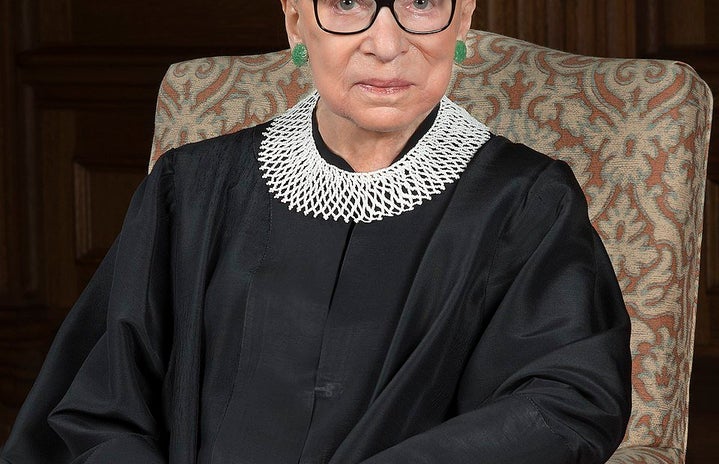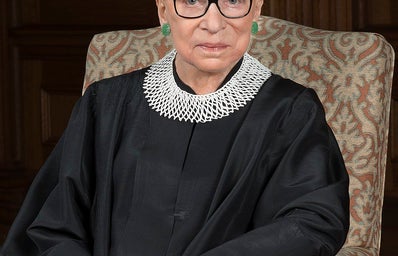From 1993 until 2020, Ruth Bader Ginsberg had been a powerhouse in the Supreme Court of the United States. While being the second woman to become an Associate Justice, she was known for her more liberal stances, along with her different neck pieces she paired with her black silk robe. She stood up for feminism in not only her dissents, but also her fashion choices. While the passing of RBG was such devastating news, her powerful presence will forever be remembered. She will remain as such an important figure that stood up for women’s rights and equal treatment for all in the courtroom.
During the initial sitting of the Supreme Court justices in 1790, the justices did not wear the customary black robes that we see them all wear today. Then, around the 1800s, the court had changed all the robes to become black. There is no exact reason for the change to don robes, but many believe that the tradition had been passed down from European countries, as many of the judges would have worn robes. Many believe that the black robes give the courtrooms a feeling of solemnity and seriousness. However, whatever the reason was for these black silk robes, they were not robes meant for women. Up until 1981, the Supreme Court justices had only been males. Sandra Day O’Connor was the first woman to ever serve as an Associate Justice of the Supreme Court. While O’Connor was not known for her eclectic collars like RBG, both had agreed that the standard robe was made in the mind that only men would be wearing them. The robe was made in order for the male’s shirt and tie to peek through. Both O’Connor and RBG deemed it necessary for them to add on something feminine and typical for a woman to wear, and thus RBG’s collars had come to light.
Ruth Bader Ginsberg had known her importance in the Supreme Court and knew her importance as a role model. She knew that because of her rarity of being a female law student and the second female Associate Justice, every choice she would make would be watched and criticized. With that, she decided to make the radical decision to feminize the traditionally male uniform. However, looking “too girlie” could be looked at as not being smart or even not taken seriously. RBG needed something to feminize her uniform, but also something that would not be overlooked. These collars worn by RBG became a weapon in the courtroom. Each collar was worn with an underlying meaning, as there was always a purpose for her fashion choices. Many of her collars had become famously noted for their different meanings. There was a “majority opinion” collar, “dissenting” collar, the “not a fan of him” collar, the “favorite” collar, and many more.
The “majority opinion” collar was worn when she was announcing an opinion for the courtroom. This collar was a yellow/beige crochet jabot with a pink trim and attached to a gold chain with gold appliques. RBG had said before that this collar was gifted to her from one of her law clerks and held a deep sentimental value. This collar was delicate in the lace-like crochet design and powerful in its gold pieces. It was a colorful and fun design that was perfect for rulings she agreed with.
The next collar is the “dissenting” collar. This was a jeweled, black bib necklace with scalloped edges. This necklace was by Banana Republic and stood out from her collection of mainly lace jabots for its black color and edgy look. This necklace was always pulled out when she wanted to communicate her disapproval in the courtroom. She had said that “it looks fitting for dissent” and became a popular piece with her fans.
The “not a fan of him” collar is one of RBG’s collars that sticks out the most. This necklace was a Stella & Dot necklace that went from black to an off-white color and resembled hundreds of spikes. This harsh-looking necklace was worn after coming back from an injury with several fractured ribs. Also during this time, Brett Kavanaugh was a newly-appointed Associate Justice and had allegations of sexual assault and heavy drinking. The message behind this necklace was to show her toughness after coming back from an injury and also her rough disapproval of this new justice.
Lastly, the “favorite” collar is one that is her most notorious. This collar was a very simple and sleek, white crochet jabot. This collar was very unembellished in design and went circular all the way around her neck. She had gotten this collar in Cape Town, South Africa, and it is one of her most worn and photographed collars. While this collar was more on the delicate and feminine side, it was an iconic piece that stood out in the courtroom.
When many people think of Ruth Bader Ginsberg, they do not associate her with fashion. In a male-dominated profession, she was a game-changer. While there was not much RBG could do with the traditionally male, black silk robe uniform, she was able to express her femininity and opinions through her neck piece choices. RBG was able to remain feminine and yet serious, as each collar was able to portray a different opinion of hers. RBG was the blueprint for many women in male-dominated jobs to be taken seriously. 2020 may have taken such a powerful feminist icon, but her legacy will forever be remembered.



